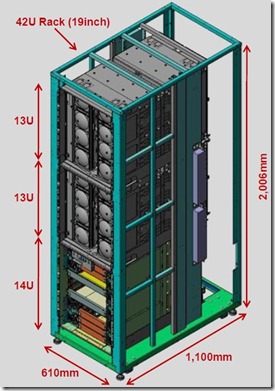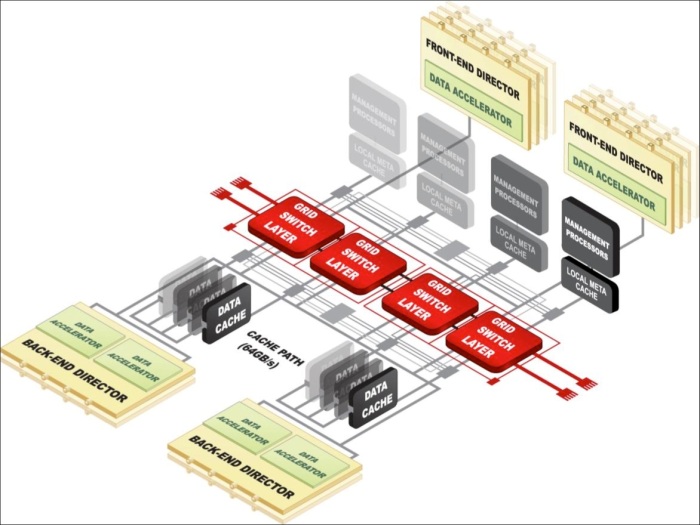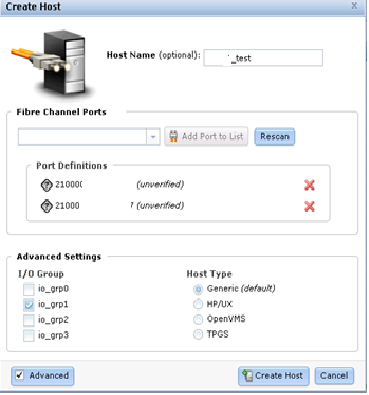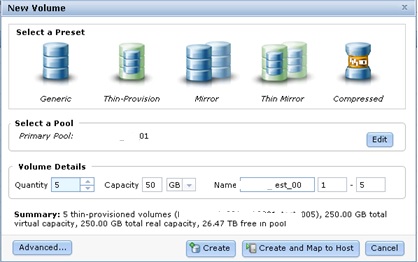| Command |
Description |
| nodefind wwn
psshow |
To find whether WWN loggedin array
Displays the status of the power supply |
| fansshow |
Displays the status of the fans |
| tempshow |
Displays the status of the temperature readings |
| sensorshow |
Displays the status of the sensor readings |
| nsshow |
Displays information in the name server |
| nsshow -t |
Displays information in the name server |
| nsshow -r |
Displays the information in the name server along with the state change registration details |
| nscamshow |
Displays detailed information of all the devices connected to all the switches in the fabric (Remote Name Servers) |
| nsallshow |
Displays the 24 bit address of all devices that are in the fabric |
| licenseshow |
Displays all the licenses that have been added in the switch |
| date |
Displays the current date set on the switch |
| bannershow |
Displays the banner that will appear when logging in unsing the CLI or webtools |
| httpcfgshow |
Displays the JAVA version the switch expects at the management console |
| switchname |
Displays the switchname |
| fabricshow |
Displays information of all the switches in the fabric |
| userconfig –show -a |
Displays the account information like role , description , password exp date , locked status |
| switchstatusshow |
Displays the overall status of the switch |
| switchstatuspolicyshow |
Displays policy set for the switch regarding Marginal(Yellow) or Down(Red) error status |
| portshow |
To show the port status |
| portcfgshow |
Displays the speed set for all ports on all slots and other detailed port information |
| configshow fabric.ops |
Displays the parameters of the switch. Ensure all switches in a fabric have the same parameters in order to communicate |
| configshow fabric.ops.pidFormat |
Displays the PID set for a switch Core , Native or Extended edge |
| switchuptime OR uptime |
Displays the uptime for the switch |
| firmwareshow |
Displays the firmware on the switch |
| version |
Displays the current firmware version on the switch |
| hashow |
Displays the status of local and remote CP’s. High availability , heartbeat and synchronization |
|
|
Port Settings
|
|
| Command |
Description |
| portcfgshow |
Displays the port settings |
| portcfg rscnsupr [slot/port] –enable |
A registered state change registration is suppressed when a state change occurs on the port |
| portcfg rscnsupr [slot/port] –disable |
A registered state change registration is sent when a state change occurs on the port |
| portname |
To assign a name for a port |
| portdisable |
To disable a port or slot |
| portenable |
To enable a port or slot |
| portcfgpersistentdisable |
To disable a port , status would not change even after rebooting the switch |
| portcfgpersistentenable |
To enable a port , status would not change even after rebooting the switch |
| portshow |
To show the port status |
| portcfgspeed , |
To set speed for a port Note – 0:auto negotiated 1,2,4 Gbit/sec , 1 : 1Gbit/sec , 2 : 2 Gbit/sec , 4 : 4Gbit/sec |
| switchcfgspeed |
To set speed for all the ports on the switch Note – 0:auto negotiated 1,2,4 Gbit/sec , 1 : 1Gbit/sec , 2 : 2 Gbit/sec , 4 : 4Gbit/sec |
| portcfgshow |
Displays the speed set for all ports on all slots and other detailed port information |
| portcfgdefault |
To set the port settings to default |
| portcfglongdistance |
To set the long distance mode . Default is L0(Normal), as per distance will display LE <=10 kms , L0.5 <=25kms , L1 <=50 kms, L2<=100kms , LD=auto , LS = Static |
| portcfgeport |
Used to disable a port from being a E port |
|
|
Setting commands
|
|
| Command |
Description |
| ipaddrset |
To set the ip address for the switch |
| bannerset |
To set the banner which will appear when logging in using the CLI or webtools |
|
|
Time and Date Settings
|
|
| Command |
Description |
| date |
Displays the current date set on the switch |
| tsclockserver 10.10.1.1 |
Instruction for the principal switch to synchronize time with the NTP server (specify ipaddress of the NTP server) |
| tsclockserver LOCL |
Instruction to stop NTP server synchronization (Local time of the switch) |
| date mmddhhmmyy |
To set the time of the switch when the NTP server synchronization is cancelled |
| tstimezone -5 |
To set the time zone for individual switches |
|
|
License Commands
|
|
| Command |
Description |
| licenseshow |
Displays all the licenses that are added in the switch |
| licenseadd |
To add a new license to the switch |
| licenseremove |
To remove a license from the switch |
| licenseidshow |
Based on Switch WWN |
|
|
Banner Commands
|
|
| Command |
Description |
| bannershow |
Displays the banner that will appear when logging in unsing the CLI or webtools |
| bannerset |
To set the banner which will appear when logging in using the CLI or webtools |
| bannerset “” |
To remove the bannerset |
|
|
Password commands
|
|
| Command |
Description |
| passwd |
To change the password for that particular login |
| passwdcfg –set -lowercase 3 uppercase 1 -digits 2 -punctuation 2 -minlength 10 -history 3 |
To set the password rules |
| passwdcfg –set -minpasswordage 1 |
To set the minimum password age in Days |
| passwdcfg –set -maxpasswordage 30 |
To set the maximum password age in Days |
| passwdcfg –set -warning 23 |
To set a warning for the expiration Days remaining |
| passwdcfg –set -lockoutthreshold 5 |
To set the account lockout thresh hold |
| passwdcfg –set -lockoutduration 30 |
To set the account lockout duration in Minutes |
| passwdcfg –setdefault |
To restore the password policy to Factory settings (min length – 8, history -1 , lockoutduration – 30) |
|
|
|
|
User Configuration (commands to administer Accounts)
|
|
| Command |
Description |
| userconfig –show -a / userconfig –show |
Displays all the account information like role , description , password exp date , locked status |
| userconfig –add jdoe -r admin -d “Jane Doe” |
To add a new account -r = role , -d = description |
| userconfig –show jdoe |
Displays all the information for the account jdoe |
| userconfig –change -e no |
To Disable an account , usually default a/cs like admin and user . But ensure before disabling the admin a/c there is another a/c with admin rights |
| userconfig –change -e yes |
To Enable an account |
|
|
NPIV Commands
|
|
| Command |
Description |
| portcfgnpivport |
Enables NPIV functionality on a port . By default on Condor based switches |
| configure |
In order to increase the no of port logins ( Default is 126 , max 255) |
|
|
SNMP
|
|
| Command |
Description |
| snmpconfig |
snmpconfig for 5.0 above fos |
| agtcfgset |
snmp config for fos below 5.0 |
| snmpmibcapset |
for choosing the MIB’s for the snmp settings |
|
|
Zoning
|
|
| Command |
Description |
| alicreate “Name”, “domain,port no” |
Used to create alias |
| alicreate “Name”,”portname1; portname2″ |
To create more than one ports under one alias |
| alidelete “Name” |
To delete alias |
| aliadd “Name”, “domain,port no” |
To add additional ports to an alias |
| aliremove “Name”, “domain,port no” |
To remove a port from the alias |
| alishow “AliName” |
To show the alias configuration on the switch |
| zonecreate “Zone Name”, “alias1; alias2″ |
To create zones based on alias |
| zonedelete “ZoneName” |
To delete a zone |
| zoneadd “ZoneName”, “alias name” |
To add additional alias into the zone |
| zoneremove “ZoneName”, “alias name” |
To remove an alias from the zone |
| zoneshow “zoneName” |
To show the zone configuration information |
| cfgcreate “Configname”, “Zone1; Zone2″ |
To create configurations by adding in zones |
| cfgdelete “ConfigName” |
To delete a configuration |
| cfgadd “ConfigName”, “Zone3″ |
To add additional zones in the configuration |
| cfgremove “ConfigName”, “Zone3″ |
To remove a zone from the configuration |
| cfgshow “ConfigName” |
To show the details of that configuration |
| cfgenable “ConfigName” |
To enable a configuration on the switch |
| cfgsave |
To have the effective configuration to be written into the flash memory |
|
|
|
|
|
|
Firmware commands
|
|
| Command |
Description |
| configupload |
Saves the switch config as an ASCII text file to an FTP server |
| configdownload |
To restore a switch configuration from ASCII text file Note – Need to disable the switch before downloading the config file |
| configure => cfgload attributes : [y] => Ensure secure config upload / download : [y] |
Fabric OS v 4.4 & above provides Secure File Copy Protocol (SCP) during upload or download of configurations |
| firmwaredownload |
To download the firmware to be installed on the switch |
| firmwareshow |
To be run after installing the firmware on the switch |
| version |
Displays the current firmware version on the switch |
| fastboot |
Needs to be run after installing the firmware . This doesnot include the post |
| reboot |
Needs to be run after installing the firmware. This includes the post |
|
|
Other commands
|
|
| Command |
Description |
| killtelnet |
To kill a particular session which is using telnet |
| configure |
To configure a switch |
| quitemode |
To switch off the quietmode |
| quietmode 1 |
To suppress messages to the console |
| switchname |
Displays the switchname |
| switchname “EXAMPLE” |
To assign a switch name |
| configure |
To disable/enable TELNETD |
| timeout |
Displays the timeout time set for Telnet session on the switch |
| timeout 10 |
To set a specific timeout time for the Telnet session |
| switchuptime OR uptime |
Displays the uptime for the switch |
| switchcfgspeed |
To set speed for all the ports on the switch Note – 0:auto negotiated 1,2,4 Gbit/sec , 1 : 1Gbit/sec , 2 : 2 Gbit/sec , 4 : 4Gbit/sec |
| fastboot |
To reboot the switch without post |
| reboot |
To reboot the switch with the post |
| switchstatusshow |
Displays the overall status of the switch |
| switchstatuspolicyshow |
Displays policy set for the switch regarding Marginal(Yellow) or Down(Red) error status |
| switchstatuspolicyset |
To change the policy set for the switch regarding Marginal(Yellow) or Down(Red) error status |










